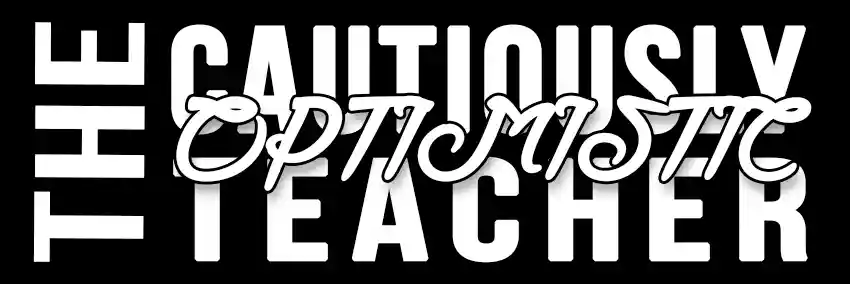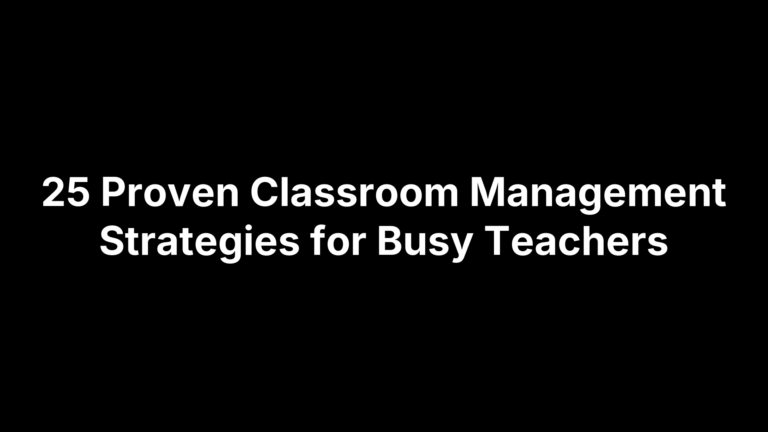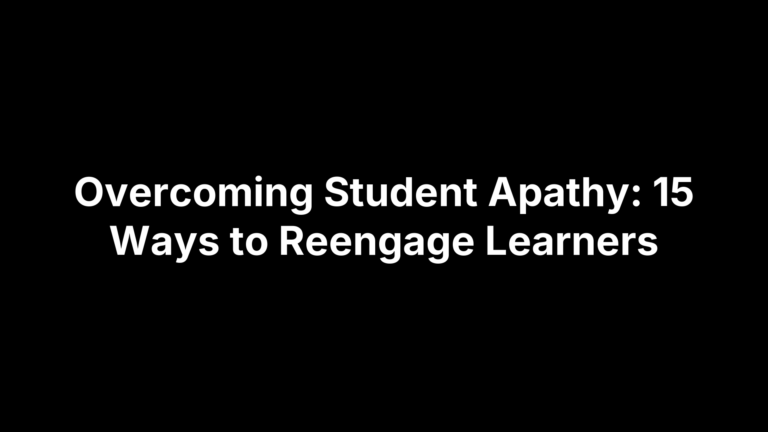Effective Teaching Strategies: 12 Research-Backed Examples
You’re juggling curriculum pacing, unfinished learning, behavior hiccups, and a full inbox—and every week another “must‑try” strategy lands on your desk. The challenge isn’t finding ideas; it’s choosing a few that reliably boost learning, fit real classrooms, and won’t take your weekend to plan. Add in wide skill gaps, multilingual learners, and limited minutes for feedback, and it’s clear: you need high‑impact moves that are practical, scalable, and evidence‑based.
This guide brings you 12 research‑backed strategies you can use across subjects and grade levels—from explicit instruction and formative checks to retrieval practice, UDL, academic discussions, culturally responsive teaching, blended/flipped models, and dual coding. We’ll also show how to plan smarter with AI using The Cautiously Optimistic Teacher’s tools to differentiate, generate questions, and streamline feedback. For each strategy you’ll get: what it is, why it works (with a quick research snapshot), how to implement it tomorrow, ready‑to‑use tools/templates, look‑fors and pitfalls, and simple ways to measure impact. Whether you teach 6th grade math or 11th grade ELA, you’ll find concrete steps to teach smarter—not harder. Ready to get practical? Here’s what works.
1. Plan smarter with AI using The Cautiously Optimistic Teacher: differentiate, generate questions, and streamline feedback
What it is
Use AI to do the heavy lifting so you can focus on teaching. The Cautiously Optimistic Teacher’s built‑in tools help you plan and deliver effective teaching strategies fast: the Differentiated Instruction Helper tailors tasks by readiness and need, the Question Generator produces leveled, standards‑aligned prompts, the Worksheet Maker turns your keywords into practice, and the Report Card Commentor streamlines specific, strengths‑based feedback.
Why it works (research snapshot)
AI amplifies practices already supported by evidence. Differentiated instruction (Tomlinson) helps address diverse needs; universal design for learning emphasizes flexible access; and formative assessment improves learning by allowing mid‑course adjustments and lowering test anxiety. Using AI to create aligned tasks, quick checks, and clear feedback makes these moves more consistent and sustainable.
How to implement it
Start with a clear learning goal and success criteria, then let AI accelerate the routine you already trust.
- Clarify the target: “Students can compare themes across two texts using textual evidence.”
- Generate leveled tasks with the Differentiated Instruction Helper (e.g., scaffolded, on‑level, extension).
- Use the Question Generator to create DoK‑varied checks (exit tickets, warm‑ups).
- Build quick practice with the Worksheet Maker; include models or partial worked examples.
- Teach, collect responses, and paste samples into the Report Card Commentor to draft targeted feedback.
- Regroup students for the next lesson based on trends from the quick checks.
Tools and templates to use
- Differentiated Instruction Helper: Ready‑to‑use tiers, accommodations, and extensions.
- Question Generator: Open‑ended, multiple‑choice, and discussion prompts at varied complexity.
- Worksheet Maker: Printable or digital sets with spiraled review.
- Report Card Commentor: Personalized, goal‑aligned feedback starters and next steps.
Look-fors and pitfalls
- Look‑fors: Clear alignment to standards and success criteria; leveled tasks that change both content and support; questions mapped to DoK; feedback that names strengths and next steps.
- Pitfalls: Over‑reliance on AI wording, misaligned items, unchecked inaccuracies, inaccessible formats. Always vet, simplify language, and add your context.
How to measure impact
- Mastery signals: Exit‑ticket accuracy by item/skill; growth from warm‑up to closure.
- Efficiency: Minutes saved in planning and feedback; turnaround time for responses.
- Equity: Engagement and success rates across groups; accommodation usage.
- Student voice: Quick surveys on clarity, challenge, and usefulness of feedback.
2. Explicit instruction and worked examples: I do, we do, you do
What it is
Explicit instruction is a gradual release approach: you model the new skill (“I do”), guide students through practice with prompts (“We do”), then move to independent work (“You do”). Worked examples are fully solved, step‑by‑step models you walk through aloud to make thinking visible before students try it.
Why it works (research snapshot)
Teacher‑directed instruction paired with frequent opportunities to respond is among the most effective approaches for boosting learning and engagement. Using clear models and guided practice reduces confusion, increases success during initial learning, and prepares students for independent application.
How to implement it
Start with a precise goal and success criteria, then plan one tight model and fast cycles of guided practice before release.
- State the goal and criteria: What good work looks like in student‑friendly language.
- Model once, out loud: Narrate steps and decisions using a concise worked example.
- We do with prompts: Solve similar items together; fade hints as accuracy grows.
- Check often: Build quick, all‑student responses every few minutes to surface misconceptions.
- You do (in sets): Short independent problems with immediate feedback between sets.
- Reflect and connect: Ask students to name the strategy they used and where it applies next.
Tools and templates to use
- I‑We‑You lesson frame: Slide/print template for goal, model, guided, independent.
- Worked example organizer: Side‑by‑side “steps” and “why this step” boxes.
- Question Generator (COT): Create scaffolded “we do” items and mixed‑DoK checks.
- Worksheet Maker (COT): Build problem sets with partial examples and faded supports.
Look-fors and pitfalls
- Look‑fors: Clear success criteria; concise modeling; frequent response opportunities; fading supports; high success rate before release.
- Pitfalls: Over‑explaining without checks; jumping to independence too soon; models that hide thinking; cluttered visuals that overload students.
How to measure impact
- Accuracy growth: Compare guided vs. independent items by skill.
- Error patterns: Track which step in the worked example causes slips.
- Responsiveness: Monitor frequency and correctness of whole‑class responses.
- Student self‑report: Quick exit prompts on clarity and confidence using the strategy.
3. Formative assessment and feedback loops: check for understanding in real time
What it is
Formative assessment is the ongoing, low‑stakes process of checking for understanding during instruction and using the evidence to adjust teaching and provide timely feedback. Instead of waiting for a unit test, you gather bite‑size data, respond quickly, and close the loop the same period or next day.
Why it works (research snapshot)
Because it happens during learning, formative assessment reduces test anxiety, surfaces misconceptions early, and lets you course‑correct before errors harden. Research distinguishes it from summative assessment (end‑of‑unit) and notes that frequent, all‑student response opportunities paired with immediate feedback increase engagement and achievement.
How to implement it
Plan your checks before you teach, keep them short, and act on what you see.
- Define the goal and success criteria in student‑friendly language.
- Insert 3–5 “hinge” checks (every 5–10 minutes) that require all students to respond.
- Use quick analysis rules (e.g., if <70% correct on the hinge, pause and reteach one step).
- Give feedback that answers: Where am I going? Where am I now? What’s my next step?
- Regroup for a 5–8 minute mini‑reteach or extension.
- Close with a 1–2 item exit ticket; use results to plan tomorrow.
Tools and templates to use
- Question Generator (COT): Build hinge questions, exit tickets, and quick polls at varied complexity.
- Worksheet Maker (COT): Create short practice sets that mirror your checks and spiral prior skills.
- All‑student response tools: Mini whiteboards, hand signals/traffic lights, paper entry/exit tickets, or simple digital forms.
- Feedback stems: “You did X well; next try Y by doing Z.”
Look-fors and pitfalls
- Look‑fors: Alignment to success criteria; every student responds; fast feedback; visible adjustments to teaching.
- Pitfalls: Grading everything (slows cycles), questions that only volunteers answer, checks that are too long to act on, waiting a day to respond.
How to measure impact
- Accuracy trends: Exit‑ticket results by skill from day to day.
- Response rates: Percentage of students responding to each check in under 30 seconds.
- Feedback cycle time: Minutes from work completion to feedback received.
- Reteach yield: Improvement on a follow‑up item after a mini‑reteach.
- Student voice: Quick survey on whether feedback was clear and helped them improve.
4. Retrieval practice and spaced repetition: make learning stick
If students ace Tuesday’s lesson but can’t recall it on Friday, the fix isn’t “more notes”—it’s structured recall over time. Retrieval practice and spaced repetition are effective teaching strategies you can weave into any unit in minutes a day.
What it is
Retrieval practice asks students to pull information from memory (without notes) through quick prompts—brain dumps, two‑item quizzes, mini whiteboard checks. Spaced repetition schedules short revisit points across days and weeks so knowledge is refreshed before it fades.
Why it works (research snapshot)
Recalling information strengthens memory far more than re‑reading, and spacing those recalls counters forgetting. Frequent, low‑stakes checks—similar to formative assessment—reduce stress, surface misconceptions early, and give all students opportunities to respond, which is linked to higher engagement and achievement.
How to implement it
- Map a quick spacing plan: same day, 48 hours, one week, and end‑of‑unit.
- Open class with a 3–5 minute “flashback” (no notes): definitions, processes, examples.
- Use retrieval formats: brain dump, one‑minute summary, two short constructed responses, or three MCQs at varied DoK.
- Interleave old and current skills (e.g., “5‑a‑day” warm‑ups).
- Reveal answers, have students self‑check, then reteach one sticky step.
- Close with a 1–2 item exit ticket targeting the day’s goal.
Tools and templates to use
- Question Generator (COT): Build spiral “flashback” items at mixed difficulty.
- Worksheet Maker (COT): Create interleaved 5‑a‑day warm‑ups and retrieval grids.
- Simple spacing calendar (planner/spreadsheet) to schedule revisit points.
- Mini whiteboards or quick polls for all‑student responses.
Look-fors and pitfalls
- Look‑fors: No‑notes recall, short cycles, mixed item types, immediate feedback, interleaving.
- Pitfalls: Turning recall into long tests, letting students peek at notes, cramming only before summatives, repeating identical questions without variation.
How to measure impact
- Compare warm‑up vs. exit‑ticket accuracy on the same skill across sessions.
- Track cumulative quiz performance (week 1 vs. week 3) on previously taught standards.
- Monitor error types to target mini‑reteaches.
- Quick student check‑ins on confidence remembering key ideas without notes.
5. Cooperative learning with structured roles: better together
What it is
Cooperative learning is students working in small, intentionally formed groups to complete tasks that require collaboration. The key is structure: clear goals, individual accountability, and defined roles so every student contributes meaningfully rather than one or two doing all the work.
Why it works (research snapshot)
When students are organized into cooperative groups with purpose, achievement rises. Research on instructional strategies finds that cooperative grouping yields a positive effect on overall learning, especially when groups are structured and expectations are explicit. Roles prevent social loafing and keep cognitive demand high for all students.
How to implement it
Start small with a 10–20 minute group task that truly needs multiple minds and has visible criteria for success.
- Create mixed‑readiness groups of 3–4; post the learning goal and success criteria.
- Assign roles (e.g., timekeeper, scribe, facilitator, spokesperson) and rotate them across lessons.
- Use a concise task card with steps, checkpoints, and a final product.
- Build in quick “all‑group checks” (1–2 minute pauses) to surface misconceptions.
- End with an individual quick write or item so accountability stays balanced.
Tools and templates to use
Use tools that make setup fast and expectations crystal clear.
- Role cards and a simple norms chart (voice level, turn‑taking, time limits).
- Task card template with step‑by‑step prompts and a mini‑rubric.
- COT tools: Question Generator for tiered group prompts; Worksheet Maker for task packets; Differentiated Instruction Helper for scaffolds and extensions.
Look-fors and pitfalls
Watch for productive talk and equitable participation; avoid vague tasks and unclear roles.
- Look‑fors: Every student speaking/doing; role language in use; artifacts aligned to criteria; on‑time checkpoints.
- Pitfalls: One student dominating; roles not rotated; tasks solvable by one person; grading only the group product.
How to measure impact
Keep evidence short-cycle and tied to both group and individual outcomes.
- Compare individual exit tickets to group products on the same skill.
- Track participation (simple tally per student) across rotations.
- Use a quick group self‑assessment on collaboration and clarity.
- Monitor error patterns from group to individual work to see if collaboration improved accuracy.
6. Academic discussion protocols: think-pair-share and Socratic seminars
What it is
Structured discussion moves—like think‑pair‑share and Socratic seminars—guide students to process ideas, cite evidence, and build on one another’s thinking. Think‑pair‑share gives quiet processing time, peer rehearsal, and then public sharing. Socratic seminars use student‑led, text‑centered questioning to probe claims, assumptions, and implications.
Why it works (research snapshot)
Discussion protocols are effective teaching strategies because they create frequent, all‑student opportunities to respond—an approach linked to higher engagement and achievement—and they promote critical thinking through purposeful questioning. Socratic questioning, in particular, encourages learners to think deeply and examine assumptions while staying grounded in evidence.
How to implement it
Begin with clear goals and a prompt worth talking about, then plan for equity and accountability.
- Post the learning target and success criteria.
- For think‑pair‑share: provide 30–60 seconds of silent think time, 60–90 seconds to pair, then harvest ideas with cold/warm calls and quick polls.
- Teach and model talk stems (“I’d like to add…,” “Where’s the evidence for…?”).
- For Socratic seminars: assign a text, have students craft questions (clarify, probe, evaluate), set norms, and run inner/outer circles with rotating roles.
- Close with a brief written synthesis or exit ticket.
Tools and templates to use
- Discussion norms and talk‑stem cards.
- Socratic seminar prep sheet (claims, evidence, questions).
- Speaking tracker and timer for equitable airtime.
- COT Question Generator to create open‑ended, DoK‑varied prompts and follow‑ups.
Look-fors and pitfalls
- Look‑fors: student‑to‑student talk, evidence‑based claims, multiple voices, clear norms, fast cycles of all‑student response.
- Pitfalls: vague prompts, teacher dominating talk, volunteers only, no think time, a few students monopolizing. Use roles, timers, and cold calling to balance participation.
How to measure impact
- Talk data: percentage of students who spoke, average turns per student, evidence citations.
- Learning checks: pre/post quick writes on the prompt; exit‑ticket accuracy tied to the target.
- Quality indicators: rubric scores for reasoning/evidence; student self‑ and peer‑reflections on clarity, listening, and use of evidence.
7. Universal design for learning: design for variability from the start
What it is
Universal Design for Learning (UDL) is a framework for planning lessons that give all students equal access to learning by offering flexible ways to engage, take in information, and show what they know. In practice, that means multiple pathways to the same clear goal.
Why it works (research snapshot)
UDL anticipates learner variability instead of retrofitting accommodations. Guidance highlights knowing students’ strengths and needs, providing flexible classrooms, and adapting information for multilingual learners—moves that reduce barriers, support goal-setting, and improve access and engagement.
How to implement it
Start with a precise learning goal, then build options upfront—don’t add them after confusion appears.
- Plan options (3 pillars): Multiple means of engagement, representation, and action/expression for the same outcome.
- Make content accessible: Use clear visuals, captions, read‑alouds, and plain‑language summaries.
- Support language: Add sentence frames, glossaries, and visuals for key terms.
- Offer smart choice: A 3‑item choice board (e.g., write, record, diagram) aligned to identical success criteria.
Tools and templates to use
Use ready tools to speed up design while keeping rigor and access aligned.
- UDL Lesson Plan Template (COT blog): Map goal, barriers, and options across the 3 pillars.
- Differentiated Instruction Helper (COT): Generate tiers, accommodations, and extensions per goal.
- Worksheet Maker + Question Generator (COT): Create accessible practice with varied formats and reading levels.
Look-fors and pitfalls
Aim for clarity and equity, not endless options.
- Look‑fors: One shared goal; options tied to the same criteria; visuals/captions; language supports; student choice without lowered rigor.
- Pitfalls: Choice without clear criteria, too many formats to manage, inaccessible PDFs, retrofitting supports after teaching.
How to measure impact
Check whether access and achievement improve for every group.
- Access: Task completion and time‑on‑task across student groups; usage rates of supports.
- Achievement: Exit‑ticket accuracy by subgroup; gaps narrowing on common criteria.
- Student voice: Quick polls on clarity, usefulness of options, and perceived challenge.
8. Metacognitive strategies: teach students to plan, monitor, and reflect
What it is
Metacognitive strategies help students manage their own learning: they set a goal (plan), track progress while working (monitor), and evaluate results (reflect). Practically, it’s a short, repeatable “before–during–after” routine embedded in lessons so students choose strategies on purpose—not by accident.
Why it works (research snapshot)
When students use self‑evaluation techniques during learning, they surface misconceptions early and make timely adjustments—exactly the strengths of formative assessment. Pairing quick checks with student reflection reduces stress, boosts engagement, and improves achievement because learners see what’s working and why.
How to implement it
Teach the routine explicitly, then use it in small doses every day.
- Before: Post the goal and success criteria; students write a 1‑sentence plan and pick a strategy (“I will annotate, then summarize”).
- During: Insert brief “monitor” pauses (traffic‑light self‑ratings; one sentence on what’s clear/unclear—the “muddiest point”).
- After: Students compare work to criteria, name one strength and one next step, and revise one example immediately.
- Spiral: Revisit the same routine across units so it becomes automatic.
Tools and templates to use
A few lightweight tools make the routine fast and consistent.
- Before–During–After card: Goal, strategy choice, monitor check, reflect/revise.
- COT Question Generator: Create reflection and self‑check prompts at varied DoK.
- COT Worksheet Maker: Add “self‑check” boxes and mini‑rubrics to practice sets.
- Feedback stems: “You did X well; next try Y by doing Z” to guide feedforward.
Look-fors and pitfalls
Aim for clarity and brevity tied to the day’s criteria.
- Look‑fors: Students naming strategies, adjusting mid‑task, revising with criteria, concise reflections.
- Pitfalls: Vague prompts (“reflect more”), reflections not linked to success criteria, journaling that eats instruction time, skipping explicit modeling of self‑talk.
How to measure impact
Keep it tight and visible.
- Compare accuracy before vs. after the revise step on the same item.
- Track how often students correctly identify their “muddiest point” and fix it.
- Monitor alignment between self‑ratings and actual performance over time.
- Use exit tickets to see if students can name the strategy they used and when to use it next.
9. Proactive classroom management: routines, expectations, and opportunities to respond
What it is
Proactive classroom management means you design the conditions for learning before problems appear: teach and practice core routines, make expectations explicit and modeled, and build frequent all‑student opportunities to respond (OTR) so every learner is engaged. The goal is smooth flow—quick starts, tight transitions, and active participation—so attention stays on academics, not logistics.
Why it works (research snapshot)
When students clearly understand what’s expected, they’re more focused and engaged. Modeling ideal behavior, encouraging initiative, and avoiding collective punishment are foundational practices. Research also supports teacher‑directed instruction with high opportunities to respond as a highly effective approach—raising engagement and achievement by ensuring many, fast chances to think and answer.
How to implement it
Plan the environment and the learning moves; then teach them like content.
- Define 3–5 must‑have routines (entering, materials, asking for help, transitions) and teach–model–practice–reteach.
- Post 2–3 positively stated expectations; model ideal behavior and co‑create examples/non‑examples.
- Schedule OTR every 2–3 minutes (choral responses, mini whiteboards, hand signals, quick polls) in your lesson plan.
- Use cues and limits (signals, timers, proximity) and deliver brief, neutral corrections; narrate positives specifically.
- Pre‑correct before tricky moments (“In 30 seconds, you’ll…”) and rehearse the routine, not the reprimand.
- Address misbehavior individually; avoid collective punishment; reteach patterns you see.
Tools and templates to use
- Routine slides and visuals: Step cards by the door; mini anchor charts for each routine.
- Signals, timers, and seating plans: For pacing, voice level, and proximity.
- COT Question Generator: Build rapid‑fire prompts for all‑student responses and checks.
- COT Worksheet Maker: Create entry/exit tickets that launch learning quickly and close with evidence.
Look-fors and pitfalls
- Look‑fors: Students can state expectations; quick, consistent transitions; high response rates; teacher circulating and scanning; specific positive narration.
- Pitfalls: Telling without practicing; calling only on volunteers; vague rules (“be respectful”); correcting the whole class for one student; inconsistent follow‑through.
How to measure impact
- Engagement: Percentage of students responding to each OTR; on‑task snapshots during work time.
- Efficiency: Transition times trending down; bell‑to‑work start within the first minute.
- Behavior data: Fewer redirects over time; patterns identified and routines retaught.
- Student voice: Short survey on clarity of expectations and sense of safety/fairness.
10. Culturally responsive teaching: connect content to students’ lives
What it is
Culturally responsive teaching (CRT) intentionally links content, examples, and classroom norms to students’ lived experiences and identities while maintaining high expectations for all learners. It’s not a theme day; it’s daily practice that affirms students, broadens perspectives, and makes rigorous learning feel relevant and doable.
Why it works (research snapshot)
When teaching is tied to students’ lived and ancestral experiences, learning becomes more personally meaningful and is learned more easily and thoroughly. Research by Geneva Gay highlights these benefits, and work by Christy Byrd shows elements of culturally relevant teaching are significantly associated with academic outcomes and ethnic‑racial identity development. Diverse classrooms thrive when instruction honors identity and sustains rigor.
How to implement it
Start by learning who your students are, then design connections that matter without lowering the bar.
- Map identities to goals: Gather interest/home surveys; name assets you can leverage.
- Audit materials: Check texts, tasks, and visuals for representation, bias, and multiple viewpoints.
- Localize examples: Rewrite problems and prompts using community contexts, languages, and issues.
- Use evidence: Require claims to be backed by data/text so relevance doesn’t replace rigor.
- Invite families/community: Bring in artifacts, interviews, or service learning tied to standards.
Tools and templates to use
Use light tools to speed relevance while keeping criteria consistent.
- COT Question Generator: Create open‑ended, culturally relevant prompts at varied DoK.
- COT Differentiated Instruction Helper: Add language supports and extensions without lowering expectations.
- COT Worksheet Maker: Embed local contexts and names while keeping the same success criteria.
- Discussion stems/norms: Promote respectful, evidence‑based talk across perspectives.
Look-fors and pitfalls
- Look‑fors: Students see themselves in content; multiple perspectives; rigorous, shared criteria; purposeful language supports; student choice with accountability.
- Pitfalls: Tokenism/“heritage month” only; stereotyping; lowering rigor in the name of relevance; teacher talk dominating; assuming culture by appearance.
How to measure impact
- Engagement: Participation and completion rates across groups; airtime balance in discussions.
- Achievement: Exit‑ticket/assessment performance by subgroup on common criteria.
- Belonging: Short surveys on relevance, respect, and identity affirmation.
- Behavior: Fewer redirects/disparities as materials and norms become more inclusive.
11. Blended and flipped learning: maximize class time for application
Blended and flipped models combine online inputs with in‑person practice so students access core content on their own time and use class for coached application. In a flipped classroom, students watch/read lesson material first; class time shifts to problem‑solving, discussion, and feedback with you as the guide on the side—an efficient way to apply effective teaching strategies.
What it is
Blended learning mixes place‑based instruction with online components (e.g., stations, short videos, interactive readings). Flipped learning “front‑loads” content at home so class can focus on higher‑order tasks, peer interaction, and teacher support.
Why it works (research snapshot)
Blended and flipped approaches make differentiation and active learning easier: students preview core ideas at their pace, then use class time for guided practice and collaboration. This frees minutes for checks for understanding and deeper application—benefits highlighted in practical guidance on blended and flipped models.
How to implement it
- Identify a unit segment to flip (definitions, worked example, or mini‑lecture). Provide a concise video/reading with clear success criteria.
- Attach a 3–5 item pre‑check to focus attention.
- Open class with a quick retrieval warm‑up; address common errors you saw in the pre‑check.
- Run application stations (problem sets, labs, debate) while you circulate and confer.
- Close with an exit ticket to plan tomorrow’s regroup.
Tools and templates to use
- COT Question Generator: pre‑checks, discussion prompts, exit tickets (varied DoK).
- COT Worksheet Maker: station tasks, retrieval warm‑ups, interleaved practice.
- COT Differentiated Instruction Helper: tiered in‑class tasks and scaffolds.
- Report Card Commentor: fast, specific feedback after conferences.
Look-fors and pitfalls
- Look‑fors: alignment between pre‑work and in‑class tasks; high student talk/do ratio; frequent all‑student responses; teacher coaching.
- Pitfalls: overly long/complex pre‑work, access barriers, misaligned class tasks, grading pre‑work for points without feedback.
How to measure impact
- Pre‑work completion and accuracy; exit‑ticket gains after mini‑reteaches.
- Time on application vs. delivery (track minutes).
- Engagement: response rates during checks, station completion.
- Student voice: quick pulse on clarity of pre‑work and usefulness of class time.
12. Dual coding and cognitive load: teach with visuals and clear explanations
When content is complex, students benefit from seeing and hearing the idea at the same time—without extra clutter. Dual coding pairs a simple visual (diagram, timeline, worked step sequence) with concise language, while cognitive load principles keep materials streamlined so attention goes to the learning goal, not the noise.
What it is
Dual coding means presenting information through a complementary visual and a brief verbal explanation. Cognitive load strategies reduce extraneous demands by chunking steps, signaling what matters, and using clean layouts so students can process and remember more effectively.
Why it works (research snapshot)
Clear models, guided practice, and accessible representations help students focus on the right steps and reduce confusion—benefits echoed across effective teaching strategies like explicit instruction, UDL (flexible representations), and formative checks that lower stress and surface misconceptions early.
How to implement it
- Identify the exact idea students must learn; write a one‑sentence success criterion.
- Create one purposeful visual (flowchart, labeled diagram, side‑by‑side example/non‑example).
- Signal key parts (bold, arrows, highlight) while you think aloud—keep narration tight.
- Chunk: teach 5–7 minute segments, then run a quick all‑student check.
- Integrate: place text next to the part of the visual it explains; avoid split attention.
- Fade support: move from fully worked example to partial, then independent practice.
Tools and templates to use
- COT Worksheet Maker: Insert labeled diagrams, example/non‑example sets, and partial worked examples.
- COT Question Generator: Build hinge questions tied to each chunk and a redraw/label exit ticket.
- UDL lesson template (COT blog): Plan multiple representations without adding clutter.
- Simple slide/graphic organizer templates with space for “Steps” and “Why this step.”
Look-fors and pitfalls
- Look‑fors: One idea per visual; clear signaling; text aligned to the graphic; short, frequent checks; gradual fading of supports.
- Pitfalls: Decorative images, walls of text, reading slides aloud, split‑attention layouts, jumping to independent work too soon.
How to measure impact
- Retrieval: Have students redraw/label the visual from memory; track accuracy over time.
- Checks: Compare hinge question results before vs. after each chunk.
- Errors: Note which step in the model drives mistakes and reteach that slice.
- Student voice: Quick poll on which visual helped and what still feels unclear.
Key takeaways
You don’t need 50 new tricks—just a tight playbook you use every day. Set clear goals, model with worked examples, get all students responding, act on evidence in the moment, and make learning stick with retrieval and spacing. Layer in structured collaboration, inclusive design, and purposeful visuals. Then measure what matters so you can iterate without adding hours to your week.
- Start with clarity: Post a learning target and success criteria for every lesson.
- Build checks in: Plan 3–5 hinge questions and require all‑student responses.
- Tighten feedback loops: “Where you’re going → Where you are → Next step,” then a quick revise.
- Make it stick: Daily retrieval warm‑ups and weekly spiral reviews.
- Structure teamwork: Roles, norms, and individual accountability on shared criteria.
- Design for access: UDL options without lowering rigor; clean visuals that reduce load.
- Use AI as a force multiplier: Differentiate, generate questions, and speed feedback.
- Track impact: Exit‑ticket accuracy, response rates, transition times, and student voice.
Want templates and ready‑to‑use prompts? Plan smarter with the tools at The Cautiously Optimistic Teacher.







